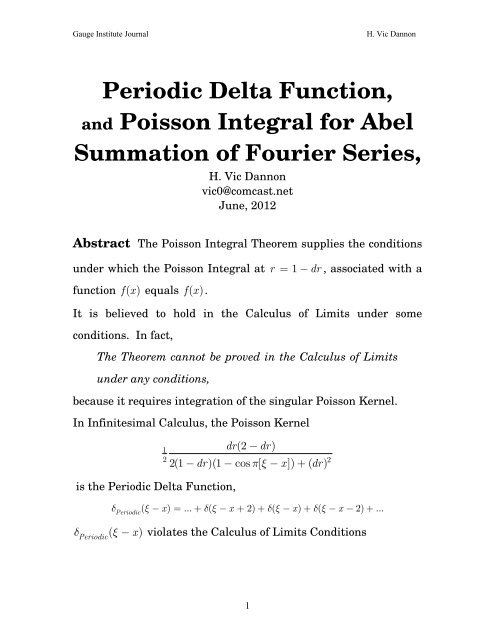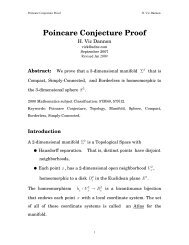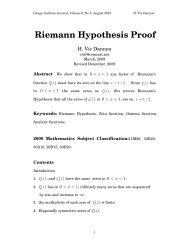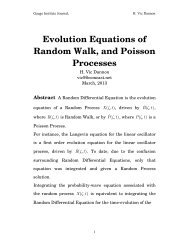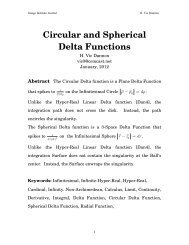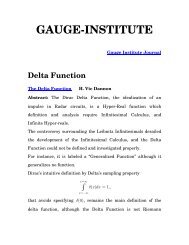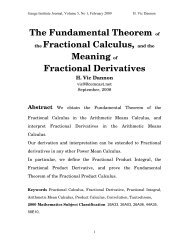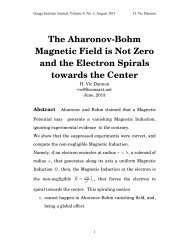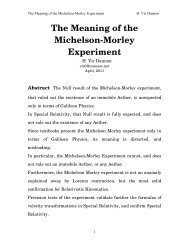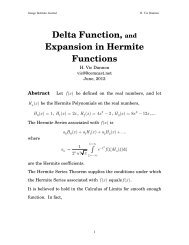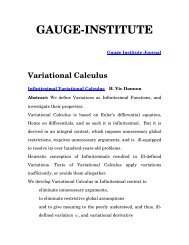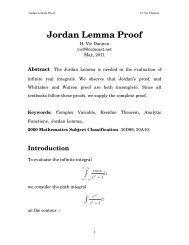Periodic Delta Function and Poisson Integral for - Gauge-institute.org
Periodic Delta Function and Poisson Integral for - Gauge-institute.org
Periodic Delta Function and Poisson Integral for - Gauge-institute.org
Create successful ePaper yourself
Turn your PDF publications into a flip-book with our unique Google optimized e-Paper software.
<strong>Gauge</strong> Institute JournalH. Vic Dannon<strong>Periodic</strong> <strong>Delta</strong> <strong>Function</strong>,<strong>and</strong> <strong>Poisson</strong> <strong>Integral</strong> <strong>for</strong> AbelSummation of Fourier Series,H. Vic Dannonvic0@comcast.netJune, 2012Abstract The <strong>Poisson</strong> <strong>Integral</strong> Theorem supplies the conditionsunder which the <strong>Poisson</strong> <strong>Integral</strong> atr =1 −dr, associated with afunctionf ( x ) equals f ( x ).It is believed to hold in the Calculus of Limits under someconditions. In fact,The Theorem cannot be proved in the Calculus of Limitsunder any conditions,because it requires integration of the singular <strong>Poisson</strong> Kernel.In Infinitesimal Calculus, the <strong>Poisson</strong> Kerneldr(2 − dr)12 22(1 −dr)(1 −cos πξ [ − x]) + ( dr)is the <strong>Periodic</strong> <strong>Delta</strong> <strong>Function</strong>,δ<strong>Periodic</strong>( ξ− x) = ... + δξ ( − x + 2) + δξ ( − x) + δξ ( −x− 2) +...δ ( ξ − x)violates the Calculus of Limits Conditions<strong>Periodic</strong>1
<strong>Gauge</strong> Institute JournalH. Vic Dannon The Hyper-realδ( x), is not defined in the Calculus of Limits,<strong>and</strong>δ ( x)is not integrable in any bounded interval.1(2δ( x + 0) + δ( x − 0) ) = 0does not replaceδ( x)at itsdiscontinuity point, x = 0 .Butδ<strong>Periodic</strong>( ξ − x)equals the <strong>Poisson</strong> <strong>Integral</strong> associated with it atr= 1 −dr.The <strong>Poisson</strong> <strong>Integral</strong> associated with any hyper-real periodicintegrable f ( x ) atr = 1 −dr , equals f ( x ).Keywords: Infinitesimal, Infinite-Hyper-Real, Hyper-Real,infinite Hyper-real, Infinitesimal Calculus, <strong>Delta</strong> <strong>Function</strong>,Fourier Trans<strong>for</strong>m, <strong>Periodic</strong> <strong>Delta</strong> <strong>Function</strong>, <strong>Delta</strong> Comb, FourierSeries, <strong>Poisson</strong> Kernel, <strong>Poisson</strong> <strong>Integral</strong>2000 Mathematics Subject Classification 26E35; 26E30;26E15; 26E20; 26A06; 26A12; 03E10; 03E55; 03E17; 03H15;46S20; 97I40; 97I30.2
<strong>Gauge</strong> Institute JournalH. Vic DannonContents0. The Origin of the <strong>Poisson</strong> <strong>Integral</strong> Theorem1. Divergence of the <strong>Poisson</strong> Kernel in the Calculus of Limits2. Hyper-real line.3. <strong>Integral</strong> of a Hyper-real <strong>Function</strong>4. <strong>Delta</strong> <strong>Function</strong>5. <strong>Periodic</strong> <strong>Delta</strong> <strong>Function</strong>, δ ( ξ − x)6. Convergent Series<strong>Periodic</strong>7. <strong>Poisson</strong> Sequence <strong>and</strong> δ ( ξ − x)<strong>Periodic</strong>8. <strong>Poisson</strong> Kernel <strong>and</strong> δ ( ξ − x)<strong>Periodic</strong>9. <strong>Poisson</strong> <strong>Integral</strong> <strong>and</strong> δ ( ξ − x)<strong>Periodic</strong>10. <strong>Poisson</strong> <strong>Integral</strong> TheoremReferences3
<strong>Gauge</strong> Institute JournalH. Vic Dannon= + z(1 + z + z + ...)12= 1 +1z1 −z2=1 1+z21−z==1 12112+ re− reiϕiϕiϕ1+ re 1−reiϕ1−re1−re−iϕ−iϕ=21 r2 21− + 2irsinϕ1+ r −2rcosϕ21− rri2 2 21 sinϕ= +1+ r − 2r cosϕ1+ r −2rcosϕThe real part isThat is,1 2+1r cosϕ+ r cos 2 ϕ + ... =2 2 21 − r1+ r −2rcosϕ21 2 −2iϕ −iϕ iϕ 2 2iϕ1 1 − r2{ .. + r e + re + 1 + re + r e + ..}=2 2Thus, the Fourier Series may have Abel Sumξ=1∫ξ=−1f211 − r( ξ)lim r ↑12 12 2 cos π (dξ+ r − r x −ξ)21+ r −2rcosϕThe <strong>Poisson</strong> <strong>Integral</strong> associated with f ( x ) at r = 1− 0 + .6
<strong>Gauge</strong> Institute JournalH. Vic Dannonξ= 12ξ=1211−r11−rlim f ( ξ) dξ = f( ξ) limr ↑12 2 22ξ=− 1 ξ=−1r ↑1∫ ∫ dξ1+ r −2r cos π( x − ξ) 1+ r −2r cos π( x −ξ)<strong>Poisson</strong> Kernel.Asr ↑ 1, the <strong>Poisson</strong> Sequence becomes the <strong>Poisson</strong> Kernel, whichis singular, <strong>and</strong> diverges at any ξ − x = 2m.x − ξ = 2m ⇒ cos π( x − ξ ) = 1,21r12 221− 1+⇒ =1+ r −2r cos π( x −ξ)1 −rr,11+1⎯⎯⎯→ =r ↑1 20 +∞Thus, the <strong>Poisson</strong> <strong>Integral</strong> diverges in the Calculus of Limits.Avoiding the singularity atξ = x , by using the Cauchy PrincipalValue of the integral does not recover the Theorem, because at anyξ −x≠2m,2 211−r11−r=2 2 2 2 1221+ r −2r cos π( x −ξ) (1 − r) + 4r sin [ π(x −ξ)]0⎯⎯⎯→ =2sin [ π( x − ξ)]r ↑1 2 120That is, the <strong>Poisson</strong> Kernel vanishes, <strong>and</strong> the integral isidentically zero, <strong>for</strong> any function f ( x ).Plots of the <strong>Poisson</strong> Sequence confirm thatIn the Calculus of Limits,the <strong>Poisson</strong> <strong>Integral</strong> Kernel is either singular or zero9
<strong>Gauge</strong> Institute JournalH. Vic Dannon1.2 Plots of <strong>Poisson</strong> Sequence with1r = 1 −For k = 37,kkplots the spikes at x = 0 , x =−2, x = 2, x =−4, x = 4For k = 49,gives 7 spikes10
<strong>Gauge</strong> Institute JournalH. Vic DannonThus, the <strong>Poisson</strong> <strong>Integral</strong> Theorem does not hold in the Calculusof Limits.1.3 Infinitesimal Calculus SolutionBy resolving the problem of the infinitesimals [Dan2], we obtainedthe Infinite Hyper-reals that are strictly smaller than ∞ , <strong>and</strong>constitute the value of the <strong>Delta</strong> <strong>Function</strong> at the singularity.The controversy surrounding the Leibnitz Infinitesimals derailedthe development of the Infinitesimal Calculus, <strong>and</strong> the <strong>Delta</strong><strong>Function</strong> could not be defined <strong>and</strong> investigated properly.In Infinitesimal Calculus, [Dan3], we can differentiate over jumpdiscontinuities, <strong>and</strong> integrate over singularities.11
<strong>Gauge</strong> Institute JournalH. Vic DannonThe <strong>Delta</strong> <strong>Function</strong>, the idealization of an impulse in Radarcircuits, is a Discontinuous Hyper-Real function which definitionrequires Infinite Hyper-reals, <strong>and</strong> which analysis requiresInfinitesimal Calculus.In [Dan5], we show that in infinitesimal Calculus, the hyper-realω=∞1( x)e i ωδ = x ω2π∫ dω=−∞is zero <strong>for</strong> any x ≠ 0 ,it spikes atx = 0 , so that its Infinitesimal Calculusx =∞∫integral is δ( xdx ) = 1,<strong>and</strong>x =−∞1δ (0) = < ∞.dxHere, we show that in Infinitesimal calculus, the <strong>Poisson</strong> Kernel isa periodic hyper-real <strong>Delta</strong> <strong>Function</strong>: A periodic train of <strong>Delta</strong><strong>Function</strong>s. And the <strong>Poisson</strong> <strong>Integral</strong> associated with a Hyper-realperiodic function f ( x ), atr = 1 −dr , equals f ( x ).12
<strong>Gauge</strong> Institute JournalH. Vic Dannon2.Hyper-real LineEach real number α can be represented by a Cauchy sequence ofrational numbers, ( r , r , r ,...) so that r → α .1 2 3The constant sequence ( ααα , , ,...) is a constant hyper-real.In [Dan2] we established that,1. Any totally ordered set of positive, monotonically decreasingnto zero sequencesinfinitesimal hyper-reals.( ι1, ι2, ι3,...)constitutes a family of2. The infinitesimals are smaller than any real number, yetstrictly greater than zero.1 1 13. Their reciprocals ( , , ,...ι 1ι 2ι 3) are the infinite hyper-reals.4. The infinite hyper-reals are greater than any real number,yet strictly smaller than infinity.5. The infinite hyper-reals with negative signs are smallerthan any real number, yet strictly greater than −∞.6. The sum of a real number with an infinitesimal is anon-constant hyper-real.7. The Hyper-reals are the totality of constant hyper-reals, afamily of infinitesimals, a family of infinitesimals with13
<strong>Gauge</strong> Institute JournalH. Vic Dannonnegative sign, a family of infinite hyper-reals, a family ofinfinite hyper-reals with negative sign, <strong>and</strong> non-constanthyper-reals.8. The hyper-reals are totally ordered, <strong>and</strong> aligned along aline: the Hyper-real Line.9. That line includes the real numbers separated by the nonconstanthyper-reals. Each real number is the center of aninterval of hyper-reals, that includes no other real number.10. In particular, zero is separated from any positive realby the infinitesimals, <strong>and</strong> from any negative real by theinfinitesimals with negative signs, −dx .11. Zero is not an infinitesimal, because zero is not strictlygreater than zero.12. We do not add infinity to the hyper-real line.13. The infinitesimals, the infinitesimals with negativesigns, the infinite hyper-reals, <strong>and</strong> the infinite hyper-realswith negative signs are semi-groups withrespect to addition. Neither set includes zero.14. The hyper-real line is embedded in , <strong>and</strong> is not ∞homeomorphic to the real line. There is no bi-continuousone-one mapping from the hyper-real onto the real line.14
<strong>Gauge</strong> Institute JournalH. Vic Dannon15. In particular, there are no points on the real line thatcan be assigned uniquely to the infinitesimal hyper-reals, orto the infinite hyper-reals, or to the non-constant hyperreals.16. No neighbourhood of a hyper-real is homeomorphic toan nball. There<strong>for</strong>e, the hyper-real line is not a manifold.17. The hyper-real line is totally ordered like a line, but itis not spanned by one element, <strong>and</strong> it is not one-dimensional.15
<strong>Gauge</strong> Institute JournalH. Vic Dannon3.<strong>Integral</strong> of a Hyper-real <strong>Function</strong>In [Dan3], we defined the integral of a Hyper-real <strong>Function</strong>.Let f () x be a hyper-real function on the interval [ ab] , .The interval may not be bounded.f () x may take infinite hyper-real values, <strong>and</strong> need not bebounded.At eacha≤x≤b,there is a rectangle with basedx dx[ x − , x + 2], height f () x , <strong>and</strong> area2f ( xdx. )We <strong>for</strong>m the Integration Sum of all the areas <strong>for</strong> the x ’s thatstart at x = a, <strong>and</strong> end at x = b,∑ f ( xdx ) .x∈[ a, b]If <strong>for</strong> any infinitesimal dx , the Integration Sum has the samehyper-real value, then f () x is integrable over the interval [ ab] , .Then, we call the Integration Sum the integral of f () x from x = a,to x= b, <strong>and</strong> denote it by16
<strong>Gauge</strong> Institute JournalH. Vic Dannonx=b∫ f ( xdx ) .x=aIf the hyper-real is infinite, then it is the integral over [, ab] ,If the hyper-real is finite,x=b∫ fxdx ( ) = real part of the hyper-real . x=a3.1 The countability of the Integration SumIn [Dan1], we established the equality of all positive infinities:We proved that the number of the Natural Numbers,Card , equals the number of Real Numbers,2 Card Card = , <strong>and</strong>we have2 Card2Card Card = ( Card) = .... = 2 = 2 = ... ≡ ∞.In particular, we demonstrated that the real numbers may bewell-ordered.Consequently, there are countably many real numbers in theinterval [ ab] , , <strong>and</strong> the Integration Sum has countably many terms.While we do not sequence the real numbers in the interval, thesummation takes place over countably many f ( xdx. )The Lower <strong>Integral</strong> is the Integration Sum where f ( x ) is replaced17
<strong>Gauge</strong> Institute JournalH. Vic Dannonby its lowest value on each interval3.2∑x∈[ a, b]⎛⎜⎝dx dx2 2[ x − , x + ]⎞inf f ( t)dx⎠⎟x− ≤t≤ x+dx dx2 2The Upper <strong>Integral</strong> is the Integration Sum where f ( x ) is replacedby its largest value on each interval3.3∑x∈[ a, b]⎛⎜⎝dx dx2 2[ x − , x + ]⎞ sup f ( t)dx⎠⎟x− ≤t≤ x+dx dx2 2If the integral is a finite hyper-real, we have3.4 A hyper-real function has a finite integral if <strong>and</strong> only if itsupper integral <strong>and</strong> its lower integral are finite, <strong>and</strong> differ by aninfinitesimal.18
<strong>Gauge</strong> Institute JournalH. Vic Dannon4.<strong>Delta</strong> <strong>Function</strong>In [Dan5], we have defined the <strong>Delta</strong> <strong>Function</strong>, <strong>and</strong> established itsproperties1. The <strong>Delta</strong> <strong>Function</strong> is a hyper-real function defined from thehyper-real line into the set of two hyper-reals⎧⎪ 1 ⎫⎨0, ⎪⎬⎪⎩dx ⎪ . The⎭hyper-real0 is the sequence 0, 0, 0,... . The infinite hyperreal1dxdepends on our choice of dx .2. We will usually choose the family of infinitesimals that isspanned by the sequences1n , 12n,1n3,… It is asemigroup with respect to vector addition, <strong>and</strong> includes allthe scalar multiples of the generating sequences that arenon-zero. That is, the family includes infinitesimals withnegative sign. There<strong>for</strong>e,1dxwill mean the sequence n .Alternatively, we may choose the family spanned by thesequences12 n ,13 n ,14 n ,… Then, 1dxwill mean the19
<strong>Gauge</strong> Institute JournalH. Vic Dannonsequence 2 n. Once we determined the basic infinitesimaldx , we will use it in the Infinite Riemann Sum that definesan <strong>Integral</strong> in Infinitesimal Calculus.3. The <strong>Delta</strong> <strong>Function</strong> is strictly smaller than ∞4. We define,1χ δ ( x) ≡ dx ( ),dx xdx⎡ ⎤ ,⎢−⎣ 2 2 ⎥⎦whereχ ⎡⎢−⎣dx,dx2 2⎧ dx dx1, x ∈ ⎡−, ⎤( x)= ⎪ ⎢ 2 2 ⎥⎨ ⎣ ⎦ .⎪⎪ 0, otherwise⎩⎤⎥⎦5. Hence, <strong>for</strong> x < 0 , δ ( x) = 0 at <strong>for</strong>dxx =− , δ( x)jumps from 0 to2dx dx⎢ ⎣,2 2 ⎥ ⎦ , 1( x)x ∈ ⎡−⎤δ = .dx1dx , at x = 0 ,δ (0) =1dx atdxx = , δ( x)drops from2 <strong>for</strong> x > 0 , δ ( x) = 0. xδ ( x) = 01dx to 0.6. If dx =1, ( x) = 1 1( x),2 1 1( x),3 1 1( x )...n[ − , ] [ − , ] [ − , ]δ χ χ χ2 2 4 4 6 67. If dx =2,n1 2 3δ ( x) = , , ,...2 2 22 cosh x 2 cosh 2x 2 cosh 3x20
<strong>Gauge</strong> Institute JournalH. Vic Dannon8. If dx =1,n− x − 2x − 3x[0, ∞) [0, ∞) [0, ∞)δ( x) = e χ ,2 e χ , 3 e χ ,...x =∞∫9. δ( xdx ) = 1.x =−∞In [Dan6], we obtained10.k =∞1 −ik( ξ−x)δξ ( − x)= e2π∫ dkk =−∞In [Dan8], we defined the <strong>Periodic</strong> <strong>Delta</strong> <strong>Function</strong>, <strong>and</strong> obtained11.δ <strong>Periodic</strong>( x ) = ... + δ ( x + 4) + δ ( x + 2) + δ ( x ) + δ ( x − 2) + δ ( x − 4) + ...1 −inπx 1 −i πx 1 1 iπx 1 inπxe e e e2 2 2 2 2= ... + + ... + + + + ... + + ...21
<strong>Gauge</strong> Institute JournalH. Vic Dannon5.<strong>Periodic</strong> <strong>Delta</strong> <strong>Function</strong> δ ( ξ − x)5.1 <strong>Periodic</strong> <strong>Delta</strong> <strong>Function</strong><strong>Periodic</strong>δ<strong>Periodic</strong>( ξ− x) = ... + δξ ( − x + 2) + δξ ( − x) + δξ ( −x− 2) +...is a periodic hyper-real <strong>Delta</strong> function, with period T = 2 .In [Dan8], we obtained1 inπξ( x) 1 iπξ( x)2 2− − − −δ<strong>Periodic</strong>( ξ − x) = ... + e + ... + e1 1 i πξ ( − x ) 1 in πξ ( − x )ee2 2 2+ + + ... + + ...22
<strong>Gauge</strong> Institute JournalH. Vic Dannon6.Convergent SeriesIn [Dan11], we defined convergence of infinite series inInfinitesimal Calculus6.1 Sequence Convergence to a finite hyper-real aa → a iff a − a = infinitesimal .nn6.2 Sequence Convergence to an infinite hyper-real Aa → A iff anrepresents the infinite hyper-real A.n6.3 Series Convergence to a finite hyper-real sa1 + a2 + ... → s iff a1 + ... + an− s = infinitesimal .6.4 Series Convergence to an Infinite Hyper-real Sa1 + a2 + ... → Siffa1+ ... +anrepresents the infinite hyper-real S .23
<strong>Gauge</strong> Institute JournalH. Vic Dannon7.<strong>Poisson</strong> Sequence <strong>and</strong> δ ( ξ − x)<strong>Periodic</strong>7.1 <strong>Poisson</strong> Sequence DefinitionLetr = 1 − , k = 1, 2, 3,...k1kThe Sequence of <strong>Poisson</strong> <strong>Integral</strong>s at r = 11 − ,kkξ=1∫ξ=−1f211 − r() ξdξ2 12+ r − 2 r cos π ( x −ξ)r =− 11k==ξ=1∫ξ=−1k − 1f () ξdξ.2( kk− 1) + 1 − 2( kk− 1)cos πξ ( −x)<strong>Poisson</strong> Sequencegives rise to the <strong>Poisson</strong> SequenceP ( ξ − x)=kk − 12( kk− 1) + 1−2( kk−1)cos πξ ( − x).7.2 <strong>Poisson</strong> Sequence is a <strong>Periodic</strong> <strong>Delta</strong> Sequence <strong>and</strong>represents the <strong>Periodic</strong> <strong>Delta</strong> <strong>Function</strong>,δ<strong>Periodic</strong>( ξ− x) = ... + δξ ( − x + 2) + δξ ( − x) + δξ ( −x− 2) +...24
<strong>Gauge</strong> Institute JournalH. Vic DannonEachP ( x)k=k − 12( kk− 1) + 1−2( kk−1)cosπx, k = 1, 2, 3,...1. has the sifting property on each interval,x =−3∫.. P ( x) dx = 1; P ( x) dx = 1; P ( x) dx = 1..x =−52. is a continuous functionkx =−1∫x =−3kx = 1∫x =−13. peaks on each of these interval to lim P ( ξ − x ) = k −1.Proof of (1)x= 1 x=1ξ−x→2m1Pk( x) dx = ( k −1)dx2( kk− 1) + 1−2( kk−1)cosπx∫ ∫ x=− 1 x=−1By [Spiegel, p.78],p−q2⎡ p − q= ( k −1) arctan tana ( p − q)( p + q)⎢⎣p + qk12a⎤ax⎥⎦kx = 1x =−121= ( k −1) arctan[ 4 k( k − 1) + 1tan πx]2π 4( kk− 1) + 12k−11/ πx = 1x =−11 1= 1 {arctan[(2 k − 1)tan π ] − arctan[(2 1)tan( )]}2 k − ππ − 2= 1.Proof of (3)1π−12 2π25
<strong>Gauge</strong> Institute JournalH. Vic DannonAs ξ −x→ 2m,k −1 k −1→ =2 kk ( − 1) + 1−2 kk ( −1)cosπx 2 kk ( − 1) + 1−2 kk ( −1)k− 1.7.3 <strong>Poisson</strong> Sequence Represents δ ( ξ − x)<strong>Periodic</strong>δ<strong>Periodic</strong>( ξ − x)=k − 12( kk−1)[1−cos πξ ( − x)] + 126
<strong>Gauge</strong> Institute JournalH. Vic Dannon8.<strong>Poisson</strong> Kernel <strong>and</strong> δ ( ξ − x)<strong>Periodic</strong>8.1 <strong>Poisson</strong> Kernel in the Calculus of LimitsThe Sequence of <strong>Poisson</strong> <strong>Integral</strong>s at1r = 1 −kkξ=1 211 − rk∫ f ξdξk→∞ 2 2r1krkπ x ξξ =−+ − −r =− 11lim ( )1 2 cos ( )k k==ξ=1∫ξ=−1k − 1f () ξdξ.2( kk− 1) + 1 − 2( kk− 1)cos π ( x−ξ)<strong>Poisson</strong> Sequencegives rise to a <strong>Poisson</strong> Sequence.Alternatively, we could use r = 1 − 1, r = 1 − 1,…23kkkkNote that the hyper-realr =1 −drincludes all such sequences.The limit of the <strong>Poisson</strong> Sequence is the <strong>Poisson</strong> Kernelk − 1klim→∞ 2( kk− 1)[1 − cos π ( x− ξ )] + . 18.2 In the Calculus of Limits, the <strong>Poisson</strong> Kernel does not haveProof:the sifting property27
<strong>Gauge</strong> Institute JournalH. Vic DannonFor ξ − x = 2m,k −1 k −1=2 kk ( −1)[1 −cos π( x− ξ)] + 1 2 kk ( −1)[1 − cos( π2 m)] + 1= k −1→ ∞.k→∞8.3 Hyper-real <strong>Poisson</strong> Kernel in Infinitesimal Calculus<strong>Poisson</strong>⎧ k 1 , ξ x 2( ξ x)⎪− − = m− = ⎨ .⎪ 0, ξ − x ≠ 2m⎪⎩Proof: At any ξ − x = 2m, the Kernel is an infinite hyper-real.At any ξ −x≠ 2m,k − 1 1= =2( kk−1)[1−cos πξ ( − x)] + 1 2[1 k −cos πξ ( − x)]+1k−1infinitesimal .8.4 Let1N = be an infinite Hyper-real, Thendr<strong>Poisson</strong>( ξ − x)==211 − r2 21−2r cos πξ ( − x)+ rr=−1 drdr(2 − dr)12 22(1 −dr)(1 −cos πξ [ − x]) + ( dr)= ... + δξ ( − x + 2) + δξ ( − x) + δξ ( −x− 2) + ...= δ ( ξ −x).periodicProof:28
<strong>Gauge</strong> Institute JournalH. Vic Dannon<strong>Poisson</strong>( ξ −x)≡==211 − r2 21−2r cos πξ ( − x)+ rr=−1 dr211 −(1 −dr)2 21 −2(1 −dr)cos πξ [ − x] + (1 −dr)dr(2 − dr)12 22(1 −dr)(1 −cos πξ [ − x]) + ( dr)For x = 2m,<strong>Poisson</strong>(2 m)==dr(2 − dr)12 22(1 −dr)(1 − cos π2 m) + ( dr)dr(2 − dr)12 2( dr)For any x ≠ 2m,= 1 1dr− . 2<strong>Poisson</strong>( x)=dr(2 − dr)12 22(1 −dr)(1 − cos πx) + ( dr)≈122dr2(1 − cos πx)= infinitesimal .There<strong>for</strong>e,<strong>Poisson</strong>⎧ 1 1 1, ξ − x = − 2 ⎧ , ξ = x ⎧, ξ − x = 2( ξ − x) = .. + dr dr dr⎨⎪ + ⎨⎪ + ⎨⎪+ ..⎪ 0, ξ −x ≠ −2 ⎪ 0, ξ ≠ x ⎪ 0, ξ −x≠ 2⎩ ⎩ ⎩29
<strong>Gauge</strong> Institute JournalH. Vic Dannon= ... + δξ ( − x + 2) + δξ ( − x) + δξ ( −x− 2) + ...= δ ( ξ − x).<strong>Periodic</strong>8.5.. + δξ ( − x + 4) + δξ ( − x + 2) + δξ ( − x) + δξ ( −x − 2) + δξ ( −x− 4) + .. ==dr(2 − dr)12 22(1 −dr)(1 −cos πξ [ − x]) + ( dr)30
<strong>Gauge</strong> Institute JournalH. Vic Dannon9.<strong>Poisson</strong> <strong>Integral</strong> <strong>and</strong> δ ( ξ − x)<strong>Periodic</strong>9.1 <strong>Poisson</strong> <strong>Integral</strong> of a Hyper-real <strong>Function</strong> f ( x )Let f ( x ) be a hyper-real function integrable on [ −1,1], so thatf (1) = f ( − 1) .Then, <strong>for</strong> eachn = ..., −3, −2, −1, 0,1,2, 3,... , the integrals12ξ=1∫ξ=−1−inπξf () ξ e dξ≡ c nexist, [Dan8], with finite, or infinite hyper-real values. Thec narethe Fourier Coefficients off ( x ).The Fourier Series associated with f ( x ) isi( −n) πx i( −1) πx i(1) πx i( n)πx−1 0 1n.. + c e + .. + c e + c + ce + .. + c e + .. =−nIt may equal The <strong>Poisson</strong> <strong>Integral</strong> associated with f ( x ) atr= 1 −dr,<strong>Poisson</strong>Sξ=121 1 − r{()} ≡ ∫ () ξ2 21 1 + r − 2 r cos πξ ( −xξ=−)fx f dξr=−1 dr=ξ=1∫ξ=−1dr(2 − dr)f () ξ2(1 −dr )(1 − cos πξ [ − x ]) + ( dr )12 2dξFor each x , it may assume finite or infinite hyper-real values.31
<strong>Gauge</strong> Institute JournalH. Vic Dannon9.2 P S{ x }Proof:δ ( ξ − ) = δ ( ξ −x)oisson <strong>Periodic</strong> <strong>Periodic</strong>ξ = 11dr(2 − dr)P S{ δ ( ξ − x) } = ∫ δ ( ξ) dξ2 2(1 )(1 cos [ ]) ( )2−dr − πξ− x + droisson <strong>Periodic</strong> <strong>Periodic</strong>ξ=−1ξ = 11dr(2 − dr)= ∫ {.. + δξ ( + 2) + δξ ( ) + δξ ( − 2) + ..} dξ2 2(1 )(1 cos [ ]) ( )2−dr − πξ− x + drξ=−11dr(2 − dr)= ... + +2 22(1 −dr)(1 − cos π[2 + x]) + ( dr)1dr(2 − dr)+ +2 22(1 −dr)(1 − cos πx) + ( dr)1dr(2 − dr)+ + ..2 22(1 −dr)(1 −cos π[2 − x]) + ( dr)= ... + .. + δ( x + 2) + δ( x) + δ( x − 2) + ..= δ <strong>Periodic</strong>( x ) . 32
<strong>Gauge</strong> Institute JournalH. Vic Dannon10.<strong>Poisson</strong> <strong>Integral</strong> TheoremThe <strong>Poisson</strong> <strong>Integral</strong> Theorem <strong>for</strong> a hyper-real function f ( x ), isthe Fundamental Theorem <strong>for</strong> Abel Summation of Fourier series.It supplies the conditions under which the <strong>Poisson</strong> <strong>Integral</strong>associated with f ( x ) atr = 1 −dr , equals f ( x ).It is believed to hold in the Calculus of Limits under someConditions. In fact,The Theorem cannot be proved in the Calculus of Limitsunder any conditions,because it requires integration of the singular <strong>Poisson</strong> Kernel.10.1 <strong>Poisson</strong> <strong>Integral</strong> Theorem cannot be proved inthe Calculus of LimitsProof:In the Calculus of Limits,ξ= 12ξ=1211−r11−rlim f ( ξ) dξ = f( ξ) limr ↑12 2 22πξξ=− 1 ξ=−1r ↑1∫ ∫ dξ1+ r −2r cos ( − x) 1+ r −2r cos πξ ( −x)<strong>Poisson</strong> Kernel.Asr ↑ 1, the <strong>Poisson</strong> Sequence becomes the <strong>Poisson</strong> Kernel, whichis singular, <strong>and</strong> diverges at any ξ − x = 2m.33
<strong>Gauge</strong> Institute JournalH. Vic Dannonξ− x = 2m ⇒ cos π( ξ − x)= 1,21r12 221− 1+r⇒ =1+ r −2r cos πξ ( −x)1 − r,11+1⎯⎯⎯→ =r ↑1 20 +∞Thus, the <strong>Poisson</strong> <strong>Integral</strong> diverges in the Calculus of Limits.Avoiding the singularity atξ = x , by using the Cauchy PrincipalValue of the integral does not recover the Theorem, because at anyξ −x≠2m,2 211−r11−r=2 2 2 2πξ1221+ r −2r cos ( −x) (1 − r) + 4r sin [ πξ ( −x)]0⎯⎯⎯→ =2sin [ πξ ( − x)]r ↑1 2 120That is, the <strong>Poisson</strong> Kernel vanishes, <strong>and</strong> the integral isidentically zero, <strong>for</strong> any function f ( x ).Thus, the <strong>Poisson</strong> <strong>Integral</strong> Theorem does not hold in the Calculusof Limits.10.2 Calculus of Limits Conditions are irrelevant to<strong>Poisson</strong> <strong>Integral</strong> TheoremProof:The <strong>Poisson</strong> Conditions are34
<strong>Gauge</strong> Institute JournalH. Vic Dannon1. f ( x ) is integrable on [ c − L,c + L]2. f ( x ) is periodic with period T = 2L13. (2fx ( + 0) + fx ( − 0) ) replaces f ( x ) at a discontinuity point.It is clear from 10.1 that the Fejer conditions on f ( x ) do notresolve the singularity of the Fejer kernel, <strong>and</strong> are not sufficient<strong>for</strong> the Fejer Summation Theorem. In Infinitesimal Calculus, by 8.4, the <strong>Poisson</strong> Kernel is the<strong>Periodic</strong> <strong>Delta</strong> <strong>Function</strong>, <strong>and</strong> by 9.2, it equals its <strong>Poisson</strong> <strong>Integral</strong>at r = 1 −dr.Then, the <strong>Poisson</strong> <strong>Integral</strong> Theorem holds <strong>for</strong> any periodic Hyper-Real <strong>Function</strong>:10.3 <strong>Poisson</strong> <strong>Integral</strong> Theorem <strong>for</strong> Hyper-real f ( x )If f ( x ) is hyper-real function integrable on [ c − L, c + L], so thatf ( c − L) = f(c + L)Then, f ( x) = P S{ f( x )}Proof: Take L = 1, <strong>and</strong> c = 0.ξ = 1∫ξ =−1oisson{ }fx ( ) = f( ξ) ... + δ( ξ − x+ 2) + δ( ξ − x) + δ( ξ −x− 2) + ... dξ.δ<strong>Periodic</strong>( ξ−x), where the period of <strong>Delta</strong> is T=235
<strong>Gauge</strong> Institute JournalH. Vic DannonBy 8.4,δ ( ξ − x) = P ( ξ − x). Thus,<strong>Periodic</strong>oissonξ=1dr(2 − dr)f ( x) = ∫ f( ξ) 2(1 −dr )(1 − cos πξ [ − x ]) + ( dr )ξ=−112 2d ξ=ξ=1∫ξ=−1f211 − r() ξ2 12+ r − 2 r cos πξ ( −x)r =− 1 drdξ= P S {()} f x .oissonIn particular, the <strong>Periodic</strong> <strong>Delta</strong> <strong>Function</strong>violates the <strong>Poisson</strong> Conditions The Hyper-realδ( x), is not defined in the Calculus of Limits,<strong>and</strong>δ ( x)is not integrable in any bounded interval.1(2δ( x + 0) + δ( x − 0) ) = 0 does not replace δ( x)at itsdiscontinuity point, x = 0 .But by 9.2,<strong>Periodic</strong>( x )satisfies the <strong>Poisson</strong> <strong>Integral</strong> Theorem.δ36
<strong>Gauge</strong> Institute JournalH. Vic DannonReferences[Achieser] Achieser, N. I., Theory of Approximation, Ungar, 1956.[Carslaw] Carslaw, H. S., “Introduction to the Theory of Fourier Series <strong>and</strong>integrals” Third Edition, Macmillan, 1930.[Dan1] Dannon, H. Vic, “Well-Ordering of the Reals, Equality of all Infinities,<strong>and</strong> the Continuum Hypothesis” in <strong>Gauge</strong> Institute Journal Vol. 6 No. 2, May2010;[Dan2] Dannon, H. Vic, “Infinitesimals” in <strong>Gauge</strong> Institute Journal Vol.6 No.4, November 2010;[Dan3] Dannon, H. Vic, “Infinitesimal Calculus” in <strong>Gauge</strong> Institute JournalVol. 7 No. 4, November 2011;[Dan4] Dannon, H. Vic, “Riemann’s Zeta <strong>Function</strong>: the Riemann HypothesisOrigin, the Factorization Error, <strong>and</strong> the Count of the Primes”, in <strong>Gauge</strong>Institute Journal of Math <strong>and</strong> Physics, Vol. 5, No. 4, November 2009.[Dan5] Dannon, H. Vic, “The <strong>Delta</strong> <strong>Function</strong>” in <strong>Gauge</strong> Institute Journal Vol.8, No. 1, February, 2012;[Dan6] Dannon, H. Vic, “<strong>Delta</strong> <strong>Function</strong>, the Fourier Trans<strong>for</strong>m, <strong>and</strong> theFourier <strong>Integral</strong> Theorem” in <strong>Gauge</strong> Institute Journal Vol. 8, No. 2, May,2012;[Dan7] Dannon, H. Vic, “Riemannian Trigonometric Series”, <strong>Gauge</strong> InstituteJournal, Volume 7, No. 3, August 2011.[Dan8] Dannon, H. Vic, “<strong>Periodic</strong> <strong>Delta</strong> <strong>Function</strong> <strong>and</strong> Dirichlet Summation ofFourier Series” posted to www.gauge-institue.<strong>org</strong>;[Dan9] Dannon, H. Vic, “Lebesgue Integration” <strong>Gauge</strong> Institute Journal Vol.7No. 1, February 2011;37
<strong>Gauge</strong> Institute JournalH. Vic Dannon[Dan10] Dannon, H. Vic,“<strong>Periodic</strong> <strong>Delta</strong> <strong>Function</strong> <strong>and</strong> Fejer-CesaroSummation of Fourier Series”, June 2012, posted to www.gauge-institue.<strong>org</strong>[Dan11] Dannon, H. Vic, “Infinite Series with Infinite Hyper-real Sum ” in<strong>Gauge</strong> Institute Journal Vol. 8, No. 3, August, 2012;[Davis] Davis, Philip, “Interpolation <strong>and</strong> Approximation” Blaisdell, 1963.[Hardy] Hardy, G. H., Divergent Series, Chelsea 1991.[Natanson] Natanson, I. P., “Constructive <strong>Function</strong> Theory” Ungar, 1964.[Rogosinski] Rogosinski, Werner, “Fourier Series” Chelsea, 1950.[Tolstov] Tolstov, Ge<strong>org</strong>i, “Fourier Series” Prentice-Hall,1962[Zygmund] Zygmund, A., “Trigonometric Series”, Second Edition, CambridgeUniversity Press, 1968.38


